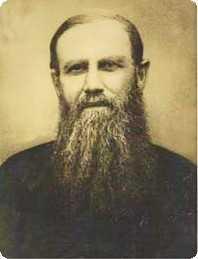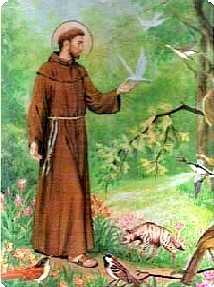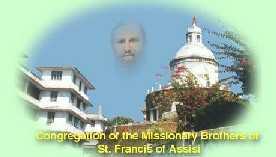Founder

Bro. Paulus Moritz, Founder
LIFE SKETCH OF Bro. PAULUS MORITZ , FOUNDER & FIRST SUPERIOR GENERAL (1869-1942)
Bro. Paulus Moritz, alias Heymann Moritz was born on 29 June 1869 at koengisberg of east Prussia (kaliningrad in the Russia Federation) of Jewish parents. He received his Jewish and primary education in Koengisberg itself.
With regard to his conversion to Catholicism there is hardly any traceable record. It could have taken place around his 16th or 17th year of his life. After this period, one sees him in the West German city of cologne. Here, he became a close associate of the veteran Jesuit missionary to India, Rev. Fr. Anthonius bodewig. Bro. Paulus joined the missionary society of the Immaculate Conception founded by Fr. Bodewig as one of its first member. This missionary society never took off the ground. A group of its member sent to the Belgian capuchin mission of Lahore in 1895 was stranded there. Its leader was one Nicholas Ludwig John, a close friend of Bro. Paulus, from Bonn, Germany. The Belgian capuchin Bishop of Lahore constituted the stranded group of Germany youths in his diocese into a congregation of Franciscan tertiary Brother whose services he hoped to enlist for the diocese.
Bro. Paulus Broke company with Fr. Bodewig by the year 1899 and associated himself with the new diocesan congregation of Lahore. Around this time, he had also knit a firm relationship with the French fransalian Bishop of Nagpur, Mgr. Pelvat. In November 1900, Bro. Paulus himself arrived in India with a few associations. He went to Nagpur from where he, in January 1901, proceeded to Lahore where Bishop Pelkmans vested him with the Franciscan habit of penance by Bishop Pelkmans. He was appointed procurator of the new congregation.
He then returned to the Nagpur group of his Brothers. His relationship with Bishop Pelkmans of Lahore had been a very stormy one and in early 1901 he finally Broke off with him and constituted themselves into a separate congregation under the Fransalian Bishop John Marry crochet of Nagpur. This happened on 21 February 1901. Bro. Paulus Moritz was chosen as the superior general of the congregation and Bro. Nicholas Ludwig john as the asst. Superior general. They chose to retain their Franciscan character. In 1920 the Nimar mission with Khandwa as its head quarters was assigned to the Brother’s congregation.
Between this period and outbreak of 1 world war the young congregation has made rapid and impressive strides in its expansion and development. They had expanded to places like Agra, Krishnagar and Daman on the Indian sub- continent and to Maslianico (n. Italy) in Europe. At the outbreak of 1 world war (1914-1919) Bro. Paulus and his German confreres were interned. Towards the close of war, while his confreres were deported, Bro. Paulus and three of his companions were allowed to stay back. The future of his congregation hanged on the thread of uncertainty. By 1921 first of the deportees began to return to India and the congregation began to regain its lost ground. In the first-ever general chapter of1930 (arranged by propaganda fide) Bro. Paulus was elected as superior general.
In the second general chapter of the congregation in 1973 he was re-confirmed in his office. At the outbreak of 2 world war, he was briefly detained by the British but owing to his ill health and advanced age, he was set free on 19 November 1941, he resigned his post as the superior general and exactly one year thereafter, i.e., on 19 November 1942, he berated his last in Mt. Poinsur, Bombay. His mortal remain are laid to rest in the monastery cemetery at Mt. Poinsur. He was a missionary at the very core of his being. His Franciscan credentials and love and commitment to the missionary charisma of the religious institute are noteworthy. May his ideals inspire all his followers.
Patron

ST. FRANCIS OF ASSISI OUR PATRON SAINT
Francis the son of a prosperous textile merchant, was born in 1182 A.D. in Assisi, Italy. As a young man he took active part in the city’s commercial, political and social life. During the war between Assisi and nearby city of Perugia, he was captured in prison. The suffering he saw during the war made him think deeply about the meaning and the purpose of life.
In 1205, he saw a vision of Jesus Christ and seeing this vision changed his life entirely, and he began to look upon God as his Heavenly Father. Thereafter he rejected his inheritance and devoted his life solely to serving the poor and tried his best to build the spirituality of the Church from within. He showed genuine concern and deep love for all creation of God. It is believed that he understood the inter relationship and mutual dependence of all living beings and perfect harmony and balance in nature.
Adopting absolute poverty as his ideal, he started preaching the Gospel and healing the sick. In 1209, he founded the Franciscan order. Many of his disciples became priests, but he remained a Brother. In 1212 he traveled to Syria, but was ship wrecked on the coast of Yugoslavia. From there he went to Morocco and met the prince. In 1219, he accompanied the crusaders to Egypt. In 1220, he returned to Italy and continued his preaching.
In 1224, while Francis was praying on Mount Alvernia, the five wounds resembling those suffered by Jesus, the Stigmata, appeared on his body. Two years later in 1226, Francis died in Portincula Chapel, near Assisi. He was canonized in 1228.
St. Francis of Assisi is remembered chiefly for his love for all living things. He is recognized as the patron saint of Ecology by the U.N. His feast day is celebrated on the 4th of October, every year.
He then returned to the Nagpur group of his Brothers. His relationship with Bishop Pelkmans of Lahore had been a very stormy one and in early 1901 he finally Broke off with him and constituted themselves into a separate congregation under the Fransalian Bishop John Marry crochet of Nagpur. This happened on 21 February 1901. Bro. Paulus Moritz was chosen as the superior general of the congregation and Bro. Nicholas Ludwig john as the asst. Superior general. They chose to retain their Franciscan character. In 1920 the Nimar mission with Khandwa as its head quarters was assigned to the Brother’s congregation.
Between this period and outbreak of 1 world war the young congregation has made rapid and impressive strides in its expansion and development. They had expanded to places like Agra, Krishnagar and Daman on the Indian sub- continent and to Maslianico (n. Italy) in Europe. At the outbreak of 1 world war (1914-1919) Bro. Paulus and his German confreres were interned. Towards the close of war, while his confreres were deported, Bro. Paulus and three of his companions were allowed to stay back. The future of his congregation hanged on the thread of uncertainty. By 1921 first of the deportees began to return to India and the congregation began to regain its lost ground. In the first-ever general chapter of1930 (arranged by propaganda fide) Bro. Paulus was elected as superior general.
In the second general chapter of the congregation in 1973 he was re-confirmed in his office. At the outbreak of 2 world war, he was briefly detained by the British but owing to his ill health and advanced age, he was set free on 19 November 1941, he resigned his post as the superior general and exactly one year thereafter, i.e., on 19 November 1942, he berated his last in Mt. Poinsur, Bombay. His mortal remain are laid to rest in the monastery cemetery at Mt. Poinsur. He was a missionary at the very core of his being. His Franciscan credentials and love and commitment to the missionary charisma of the religious institute are noteworthy. May his ideals inspire all his followers.
Society

ONGREGATION OF THE MISSIONARY BROTHERS OF ST. FRANCIS OF ASSISI
St. Francis Institute, having St. Francis School and other many institutions is situated on the hillock of Mandapeshwar. Presently known as Mount Poinsur.
It is one of the oldest institution in the suburbs of Mumbai. The Institution had its humble origin way back in 1908, When the Bishop of Bombay invited the Congregation of the Franciscan Missionary Brothers. Very Rev. Bro. Paulus Moritz, the Founder of the Congregation, accompanied with a few of his fellow brothers, who were with missionary zeal filled with the sole intention of improving the lot of poor, needy and marginalized ones, commenced their activities by constructing a thatched house for the Brothers. Gradually they put up a similar structure for the orphans too. One can possibly imagine the various hardships and difficulties, the veteran had to encounter nine decades ago in brothers began their activities by starting an orphanage accommodating nearly 100 orphans, caring for their physical, psychological and spiritual needs along with their education.
The First and Second World war, halted the progressive march of this institution since, most of the Brothers then hailed from Germany and had to be placed in the Internment Camp under the British rule and to add to it, the devastating cyclone of 1948 in Bombay uprooted all the structure at Mount Poinsur. This forced the Brothers to begin the reconstruction activities with constrained personnel and financial resources. Well, this could now, be viewed as a blessing in disguise, since that gradually gave rise to the present imposing complex.
The school secured recognition in the year 1951. Initially the school strength was made up of orphans from St. Francis Orphanage itself. However, when the school began to show better results in all spheres of student’s life, the day scholars also started trickling in.
From 1964, the I.T.I. complex began to take shape, in order to impart technical skills to the boys from the Orphanage, so as to enable them to secure a gainful employment in nearby factories. Today, after 90 years of its existence, the institution educates almost 8500 students in the school as well as in I.T.I. It has now become the most sought after institute both for its academic, technical as well as all-round performance in sports and co-curricular activities.
He then returned to the Nagpur group of his Brothers. His relationship with Bishop Pelkmans of Lahore had been a very stormy one and in early 1901 he finally Broke off with him and constituted themselves into a separate congregation under the Fransalian Bishop John Marry crochet of Nagpur. This happened on 21 February 1901. Bro. Paulus Moritz was chosen as the superior general of the congregation and Bro. Nicholas Ludwig john as the asst. Superior general. They chose to retain their Franciscan character. In 1920 the Nimar mission with Khandwa as its head quarters was assigned to the Brother’s congregation.
Between this period and outbreak of 1 world war the young congregation has made rapid and impressive strides in its expansion and development. They had expanded to places like Agra, Krishnagar and Daman on the Indian sub- continent and to Maslianico (n. Italy) in Europe. At the outbreak of 1 world war (1914-1919) Bro. Paulus and his German confreres were interned. Towards the close of war, while his confreres were deported, Bro. Paulus and three of his companions were allowed to stay back. The future of his congregation hanged on the thread of uncertainty. By 1921 first of the deportees began to return to India and the congregation began to regain its lost ground. In the first-ever general chapter of1930 (arranged by propaganda fide) Bro. Paulus was elected as superior general.
In the second general chapter of the congregation in 1973 he was re-confirmed in his office. At the outbreak of 2 world war, he was briefly detained by the British but owing to his ill health and advanced age, he was set free on 19 November 1941, he resigned his post as the superior general and exactly one year thereafter, i.e., on 19 November 1942, he berated his last in Mt. Poinsur, Bombay. His mortal remain are laid to rest in the monastery cemetery at Mt. Poinsur. He was a missionary at the very core of his being. His Franciscan credentials and love and commitment to the missionary charisma of the religious institute are noteworthy. May his ideals inspire all his followers.
Other Institutes
Our other Institutes at Borivali, Mumbai
St. Francis Boys’ Home
St. Joseph Pre-Primary School
St. Francis D’Assisi Primary School
St. Francis D’Assisi High School
St. Francis Junior College
St. Francis Industrial Training Institute
St. Francis Institute of Art and Design
St. Francis Trade Test Centre
St. Francis Institute of Technology
St. Francis Institute of Management & Research
St. Francis Institute of Hotel Management
Our School
OUR VISION
OUR MISSION
School Timings


